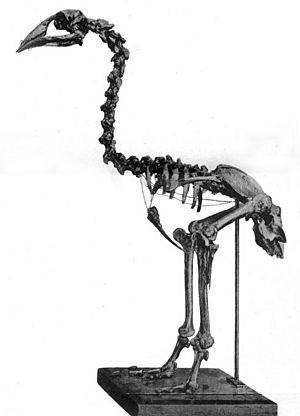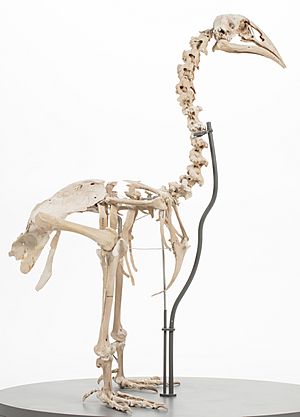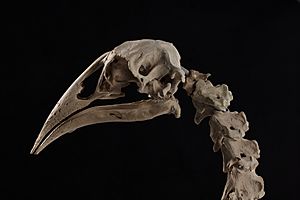Adzebill facts for kids
Quick facts for kids Adzebills |
|
|---|---|
 |
|
| Skeleton of A. otidiformis, Canterbury Museum | |
| Scientific classification |
|
| Kingdom: | Animalia |
| Phylum: | Chordata |
| Class: | Aves |
| Order: | Gruiformes |
| Family: | †Aptornithidae Mantell, 1848 |
| Genus: | †Aptornis Owen, 1844 |
| Species | |
|
|
| Synonyms | |
|
|
The adzebills, known by the genus name Aptornis, were two types of large, flightless birds. They were the North Island adzebill (Aptornis otidiformis) and the South Island adzebill (Aptornis defossor). These birds lived only in New Zealand and are now extinct. They belonged to their own special bird family called Aptornithidae. Scientists have also found fossils of an even older adzebill species, Aptornis proasciarostratus, from the Miocene period.
Contents
What Kind of Bird Were Adzebills?
When adzebill fossils were first found, people thought they were small moa, which are also flightless birds. However, adzebills were not moa. Scientists have been trying to figure out exactly where adzebills fit in the bird family tree.
- Some thought they might be related to Gruiformes, a group that includes cranes and rails.
- Others suggested they might be closer to birds like the kagu from New Caledonia or trumpeters.
- Newer genetic studies from 2011 showed that the South Island adzebill (A. defossor) was indeed a gruiform.
- In 2019, more detailed studies looked at their DNA. One study suggested adzebills were closely related to a family called Sarothruridae (flufftails). Another study, using both bones and DNA, found they might be closer to trumpeters (Psophiidae). So, scientists are still working to find the exact answer!
What Did Adzebills Look Like?
Adzebills were quite large, standing about 80 centimeters (about 31 inches) tall. They weighed around 18 kilograms (about 40 pounds). This made them similar in size to small moa.
- They had very strong legs, which helped them move around.
- Their most unique feature was their huge, downward-curving, pointed beak.
- Adzebills were flightless. Their wings were tiny, even smaller than a dodo's wings compared to their body size. This means they could not fly at all.
- The two adzebill species mainly differed in size. The North Island adzebill was smaller than the South Island adzebill. We don't know what color their feathers were when they were alive.
Where Did Adzebills Live and What Did They Eat?
Fossils of adzebills have been found in drier, lowland areas of New Zealand. Scientists believe they were omnivores, meaning they ate both plants and animals.
- By studying their bones, scientists found that adzebills likely ate things higher up in the food chain.
- They probably hunted and ate large invertebrates (like big insects or worms).
- They also likely ate lizards, tuataras (a type of reptile unique to New Zealand), and even small birds.
Why Did Adzebills Disappear?
Adzebills were not as common as moa, but they faced the same dangers.
- When Polynesian people settled in New Zealand, they hunted large birds like the adzebills.
- The Polynesian rats and dogs that came with the settlers also likely ate adzebill eggs and young birds.
- Because of these pressures, adzebills became extinct before European explorers arrived in New Zealand.
See also
 In Spanish: Aptornis para niños
In Spanish: Aptornis para niños




